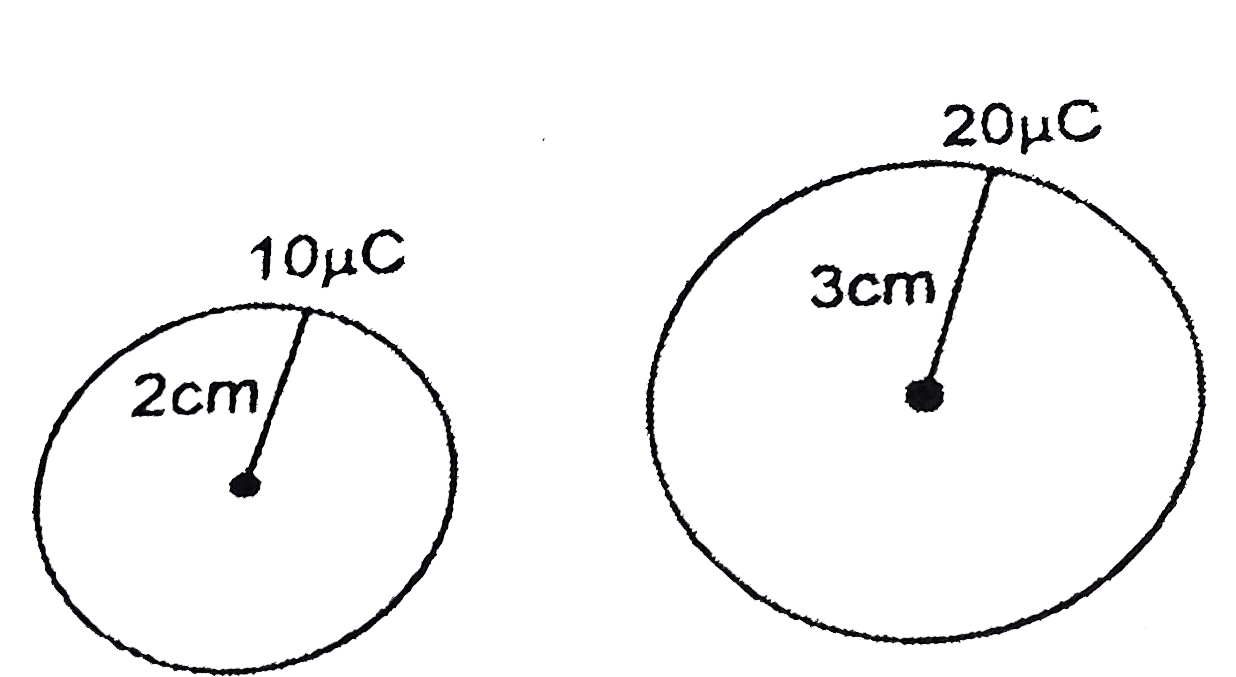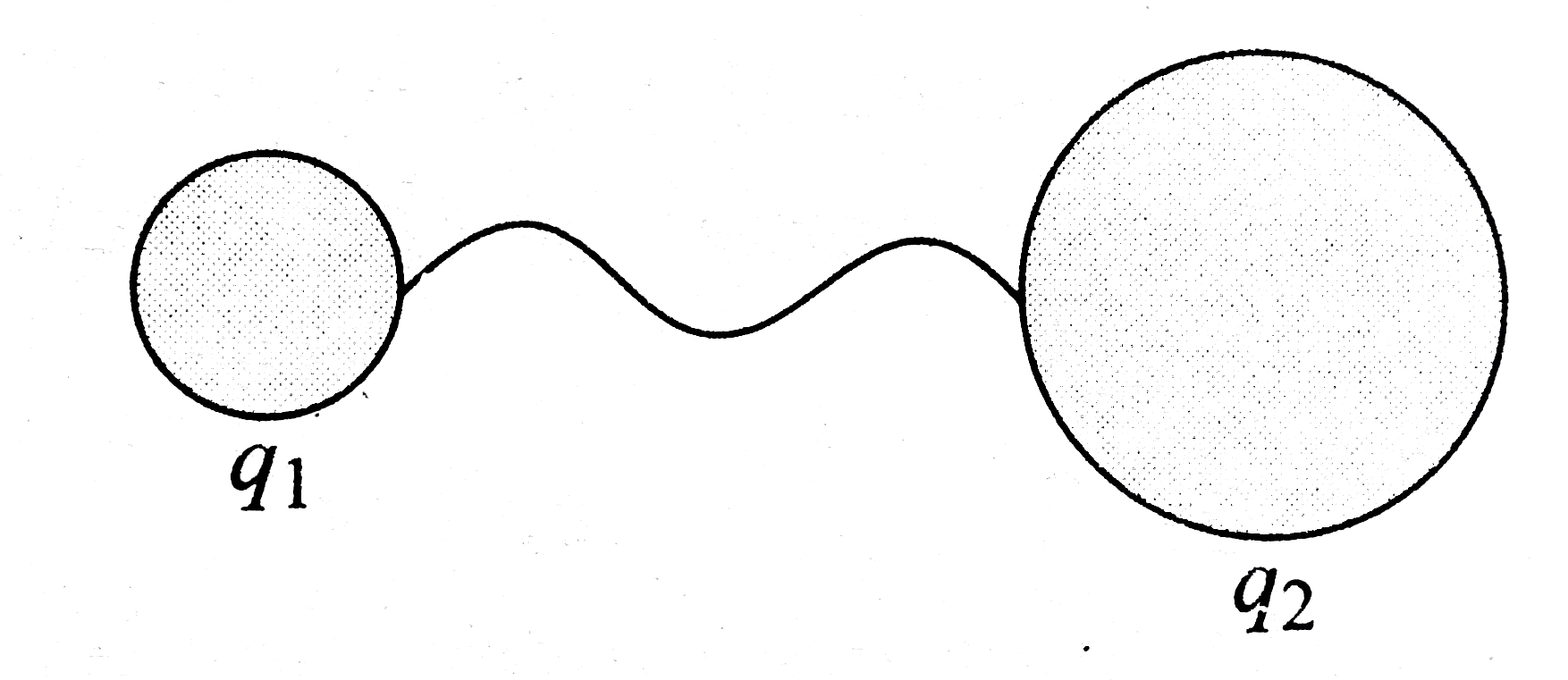Two isolated conducting spheres of radius have and charges, respectively, and are at a large distance from each other. They are now connected by a conducting wire . A long time after this is done the charges on are respectively :
on both
The correct Answer is:A
To solve the problem, we need to determine the final charges on the two conducting spheres S1 and S2 after they are connected by a conducting wire. Here are the steps to find the solution:
Step 1: Calculate the initial total charge
The initial charges on the spheres are:
- Charge on S1 ( Q1 ) = 12μC
- Charge on S2 ( Q2 ) = −3μC
The total initial charge Qinitial is given by:
Qinitial=Q1+Q2=12μC+(−3μC)=12μC−3μC=9μC
Step 2: Understand the concept of potential
When the two spheres are connected by a conducting wire, charge will flow between them until they reach the same electric potential. The potential V of a conducting sphere is given by:
V=k⋅QR
where k is Coulomb's constant, Q is the charge on the sphere, and R is the radius of the sphere.
Step 3: Set up the equations for final charges
Let Qf be the final charge on S1 and Q′f be the final charge on S2. Since charge is conserved:
Qf+Q′f=Qinitial=9μC
The radii of the spheres are:
- Radius of S1 = 23R
- Radius of S2 = 13R
The potentials of the spheres after they are connected must be equal:
k⋅Qf23R=k⋅Q′f13R
Step 4: Simplify the potential equation
Canceling k and R from both sides gives:
Qf23=Q′f13
This simplifies to:
3Qf=2Q′f
Step 5: Solve the equations
Now we have two equations:
1. Qf+Q′f=9
2. 3Qf=2Q′f
From the second equation, we can express Q′f in terms of Qf:
Q′f=32Qf
Substituting this into the first equation:
Qf+32Qf=9
52Qf=9
Qf=9×25=185μC=3.6μC
Now substituting back to find Q′f:
Q′f=9−Qf=9−3.6=5.4μC
Final Charges
Thus, the final charges on the spheres are:
- Charge on S1 ( Qf ) = 3.6μC
- Charge on S2 ( Q′f ) = 5.4μC
The initial charges on the spheres are:
- Charge on S1 ( Q1 ) = 12μC
- Charge on S2 ( Q2 ) = −3μC
Qinitial=Q1+Q2=12μC+(−3μC)=12μC−3μC=9μC
When the two spheres are connected by a conducting wire, charge will flow between them until they reach the same electric potential. The potential V of a conducting sphere is given by:
V=k⋅QR
where k is Coulomb's constant, Q is the charge on the sphere, and R is the radius of the sphere.
Let Qf be the final charge on S1 and Q′f be the final charge on S2. Since charge is conserved:
Qf+Q′f=Qinitial=9μC
- Radius of S1 = 23R
- Radius of S2 = 13R
k⋅Qf23R=k⋅Q′f13R
Canceling k and R from both sides gives:
Qf23=Q′f13
This simplifies to:
3Qf=2Q′f
Now we have two equations:
1. Qf+Q′f=9
2. 3Qf=2Q′f
Q′f=32Qf
Qf+32Qf=9
52Qf=9
Qf=9×25=185μC=3.6μC
Q′f=9−Qf=9−3.6=5.4μC
Thus, the final charges on the spheres are:
- Charge on S1 ( Qf ) = 3.6μC
- Charge on S2 ( Q′f ) = 5.4μC
Topper's Solved these Questions
Similar Questions
Two isolated metallic solid spheres of radii R and 2R are charged such that both have the same charge Q. The spheres are located far away from each other and connected by a thin conducting wire. Find the heat dissipated in the wire.
View SolutionTwo isolated metallic solid spheres of radii R and 2R are charged such that both of these have same charge density σ. The spheres are located far away from each other and connected by a thin conducting wire. Find the new charge density on the bigger sphere.
View Solution
Knowledge Check
- Question 1 - Select One
Two metal spheres A and B of radii a & b (a < b) respectively are at a large distance apart. Each sphere carries a charge of 100μC the sphere are connected by a conducting wire, then
ACharge will flow from A to BBCharge will flow from B to ACNO charge flows in the wireDAll charges will reside on the connecting wire - Question 2 - Select One
Two small conducting spheres of equal radius have charges +10μC and −20μC respectively and placed at a distance R from each other. They experience force F1. If they are brought in contact and separated to the same distance, they experience force F2. The ratio of F1 to F2 is
A1:8B−8:1C1:2D−2:1 - Question 3 - Select One
Paragraph for Questions 53 and 54: An isolated system consists of two conducting spheres A and B. Sphere A has five times the radius of sphere B. Initially, the spheres are given equal amounts of positive charge and are isolated from each other. The two spheres are then connected by a conducting wire.
Note: The potential of a sphere of radius R that carries a charge Q is V=kQ/R, if the potential at infinity is zero.
Determine the ratio of the charge on sphere A to that on sphere B,qA/qB, after the spheres are connected by the wire.A1B1/5C5D25
Figure shows two conducting spheres separated by large distance and of radius 2 cm and 3 cm containing charges 10μC and 20μC respectively. When the spheres are connected by a conducting wire then find out following :
(i) Ratio of the final charge.
(ii) Final charge on each sphere.
(iii) Ratio of final charge densities.
(iv) Heat produced during the process.
 View Solution
View SolutionFind ratio of charges S1 and S2 of they are connected by wire.
 View Solution
View SolutionParagraph for Questions 53 and 54: An isolated system consists of two conducting spheres A and B. Sphere A has five times the radius of sphere B. Initially, the spheres are given equal amounts of positive charge and are isolated from each other. The two spheres are then connected by a conducting wire.
Note: The potential of a sphere of radius R that carries a charge Q is V=kQ/R, if the potential at infinity is zero.
Which one of the following statements is true after the spheres are connected by the wire?View SolutionThe insulated spheres of radii R1 and R2 having charges Q1 and Q2 respectively are connected to each other. There is
View SolutionTwo spherical conductors of radii R1andR2 are separated by a distance much larger than the radius of eighter sphere. The spheres are connected by a conducting wire as shown in (Fig. 3.128). If the charges on the spheres in equilibrium are q1andq2, respectively, what is the ratio of the field strength at the surfaces of the spheres ?
 .View Solution
.View Solution

